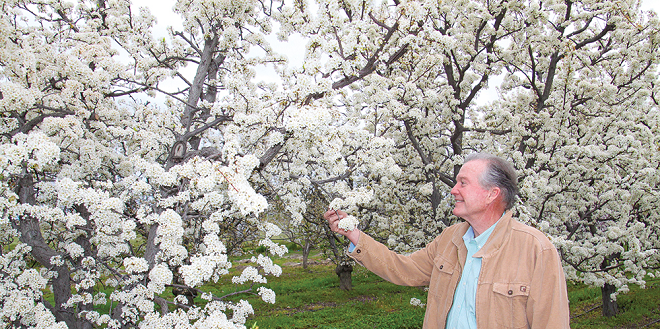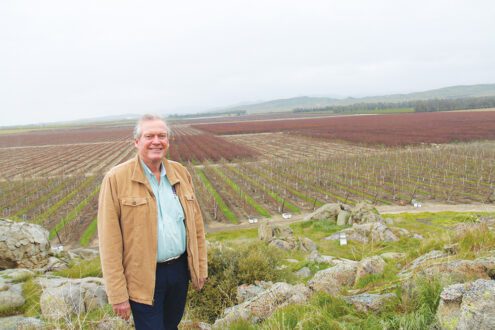

Sep 15, 2023California’s Murray Family Farms endures challenges
Murray Family Farms, owned by Steve and Vickie Murray, has discovered that growing cherries, berries and other tree fruit in the southern San Joaquin Valley’s desert region is highly challenging.
South of Bakersfield, the farm’s signature crop is sweet cherries, but it also grows blueberries, peaches, nectarines, tart cherries, blackberries, elderberries and exotic fruit, for a total of more than 40 crops.


As a child in Southern California, Steve Murray would place ant traps, trap gophers and lay smudge pots in the family’s citrus groves. While the Murrays are a first-generation farming operation, his family on his mother’s side were fourth-generation growers who experimented with other crops new to the region, including persimmons.
The day Murray’s mother was born, his grandfather died in a beekeeping-related explosion. He died from burns and bee stings after his smoker got too close to a fuel tank. The accident left Murray’s mother and grandmother to run the farm.
At the University of California-Riverside, Murray initially studied zoology and veterinary science but switched to plant science. After graduating in 1977, he worked in ag-related jobs for the state and county and became a personal crop advisor before entering beekeeping as a side business. When a long drought prevented hive splitting in 1989, he sold his beekeeping equipment and started a farm with his wife.
The farm first planted 10 acres of sweet cherries and 10 acres of table grapes until Pierce’s disease took out the grapes. A friend offered to grow a cherry nursery, allowing the Murrays to increase production and sell fruit at Southern California farmers markets.
The Bakersfield area produces fruit ahead of other regions because it warms up sooner in the season, but achieving adequate chilling hours, pests such as spotted-wing drosophila (SWD) and uncertainty of enough irrigation water make growing there demanding.
Cherry woes
Though cherry trees can produce for 60 years — longer if properly cared for — Murray has replaced every cherry tree he’s planted.
“There are no perfect cherries for growing down here,” he said.
Bings, the original variety he planted, produced too many spurs and doubles. The region requires varieties that are early, large, firm, sweet, require fewer chill hours and tolerate rain better.
Eight of the warmest winters in the region occurred in the last decade, exacerbating the lack of chill hours. “There are a lot of things you can do to manipulate a tree and to get it to set fruit, but you can only go so far with that,” Murray said. “Sometimes we wonder if cherries will grow here. Some years, you don’t have a crop.”
Murray is studying pre- and probiotics and root stimulants.
Despite the current cycle of higher temperatures, a 2006 freeze wiped out the cherry crop and forced Murray to diversify fruit production and carry expensive crop insurance, which consumes the first 10% of a growers’ income, he said.
Murray experiments with different tree systems, and is considering bi-axles or a two-scaffold system to make smaller trees with higher-density plantings.
Others include upright fruiting arm orientation, pedestrian planting styles as well as the Kym Green Bush (KGB), which allows for harvesting without ladders or platforms.
“You are seeing a lot of growers trying to get shorter orchards,” Murray said. “Everybody is looking at ways that they can try to reduce labor. You can see the mechanization of harvesting a lot of different kinds of fruit. I don’t see anything on the horizon that’s going to promote mechanically harvested cherries.”
Mature cherry and apple trees can grow to 14 feet and higher, and some insurance companies might not insure workers picking that high. Total tree renewal seems to be the only way to rejuvenate KGB orchards. Most growers choose to abandon the KGB system, and prune back to a “steep leader” orchard orientation to remain 100% in production, Murray said.
Berry challenges
Blueberries require many efficiencies of scale. Because mechanical harvesting can lead to soft fruit being packed, Murray hand harvests, which commands premium prices.
“You can almost not afford to handpick blueberries,” Murray said.
Blueberries require lower soil pH values than the high levels found in the desert’s alkaline soil.
“Blueberries all come down to your soil,” Murray said. “It’s the pH and you must master that through organic supplements that lower your soil acidity. That’s the whole thing with blueberries, and renewing your wood.”
About 40% of Murray’s production is organic, with some crops solely sold directly to consumers as organic. The process of organic farming can be more frustrating than conventional because it isn’t as efficient and involves more work, Murray said. Because of unfavorable winters with a lack of proper chill hours as well as damage from birds and SWD, Murray Family Farms didn’t harvest the first four years of organic production.
Smaller farming operations can pay more attention to detail.
“One of the things my father said was ‘the best fertilizer is the growers’ footprint,’” Murray said. “If you can go out and walk the fields and look at the trees and be engaged, even though we have modernized our ways of measuring soil moisture, the temperatures and the degree days to know what’s coming at you, there’s no substitute for being out in the middle of it.”
Major cherry crop hurdles include X-disease and little cherry virus. When the Murrays started farming, the biggest insect challenge was hordes of grasshoppers leaving the foothills, so many that roads turned yellow from vehicles running over them. Murray said he sees fewer sightings of fungi, rot and mold.
While many farmers are highly isolated in their businesses, Murray’s farm sees thousands of people visiting for agritourism and u-pick offerings. They sell at multiple farmers markets throughout the season, but their main sites of commerce, the rural Bakersfield Big Red Barn and Little Purple Barn, feature fruit picking and fresh baked goods at both sites.
“The great joy of mine is to improve the quality of people’s lives,” he said. “This is closing the loop on a childhood dream on what I studied in school and did in my life, as opposed to blundering into it or inheriting it.”
— Doug Ohlemeier, assistant editor
Top photo: Steve Murray of Murray Family Farms, which focuses on cherries, but also grows other tree fruit as well as berries in the southern San Joaquin Valley’s desert region. Photos by Doug Ohlemeier.














